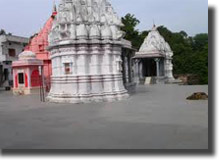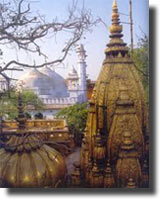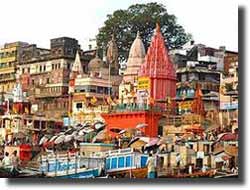Location :
History of the Temple
Kashi Vishwanath Temple in Varanasi is also called Golden Temple which was at times in full of ups and downs. This particular temple and city of Varanasi has always been on the receiving end for the invaders be it Afghans, Turks, Rohilas or Marathas.
This temple has been built and razed to the ground several times in its history. It was first destroyed in 13th century by Bakhtiyar Khilji and was later rebuild. Then later Emperor Akbar donated several acres of villages to the temple's trust that was later cut down substantially by Aurangzeb. Rani Ahilyabai Holkar in the year 1776 from Indore built the present temple that stands in Varanasi. At that time Maharaja Ranjit Singh of Lahore had donated 800-kilogram gold-plating of the towers that gave the temple its colloquial name.
Significance of the Temple

It has been depicted in the scriptures that when the earth was submerged under water (Pralaya), Lord Shiva upheld and holed this place by his Trishul and belief even conveys that those who come and die here attain liberation (Moksha). Lord Shiva gives the Tarak Mantra to the devotees who die here. One who prays and worships Lord Vishweshwar with devotion attains all his desires of happiness and liberation; and even the devotees who incessantly recite his name attain all siddhis and finally gets liberated.

According to some scholars the other lingas like the Mahakala, Nikumbheshvara, Dandapanisvara, Vaikuntheshvara, kala Bhairava, kapileshvara, Kubereshvara bear the names of Yakshas. There are also images of Saubhagya Gauri, Shringar Gauri, Savitri, Vighneshvara Ganesha, Vyaseshvara, etc. along with a cluster of small lingas to the north which is called the court of Vishwanatha.
The Vishwanatha temple consists of a mandapa and a sanctum. Inside the sanctum a linga is set into the center of the floor in a square silver altar. The linga is of black stone. Though the interior of the temple is not large and elaborate it presents the peaceful atmosphere ideal for worship.

The Vishweshwara Jyotirlinga which is considered as the one among all the jyothrilinga has a very special and unique significance in the spiritual history of India. Tradition says that merits earned by the darshan of other jyotirlinga which are scattered in various parts of India is accrued by a devotee by a single visit to Kashi Vishwanath Temple.
Inherently for long years the Kashi Vishwanath Temple has been a living incarnation of our timeless cultural traditions and highest spiritual values. The Vishwanath Temple has been visited by all great saints like Adi Shankaracharya, Ramkrishna Paramhansa, Swami Vivekanand, Goswami Tulsidas, Maharshi Dayanand Saraswati, Gurunanak and even several other spiritual personalities.
Time to Visit
Kashi Vishwanath Temple in Varanasi opens daily at 2.30a.m. And the Mangala Aarati is from 3 to 4 a.m. From 4 to 11 a.m. general Darshan is allowed for the devotees. During 11.30 to 12 a.m. a mid day Bhog Aarati is being done . Again from 12 noon to 7 p.m. devotees are free to have darshan. From 7 to 8.30 p.m., evening arati which is called the Sapta Rishi Aarati is done after which darshan is again possible until 9 p.m. when Shringar/Bhog Aarati starts. After 9 p.m. darshan from out side only is possible. Shayana Aarti starts at 10.30p.m.The Temple closes at 11 p.m. Most of the Prasad like milk, clothes and other such offerings are given to the poor and needy.
Other places to Visit
The Ghats
Devotees usually visit the ghats to have a ritual bath and perform puja to the rising sun in Ganga. It is a very spiritual and serene beauty to see people performing morning prayers in Varnasi. The Dasashvamedh ghat offers a magnificent view of the Gangas riverfront . Other special ghats are the Asi, Barnasangam, Panchganga and Manikarnika.
Tulsi Manas Mandi
7 km from the railway station is the temple which is dedicated to Lord Rama. It is believed to be situated where saint-poet Tulsi Das lived and has written the epic Ram Charit Manas. An exquisite structure of white marble, it has the text of Ram Charit Manas engraved on its walls.
|
Durga Temple
7 km from railway station, is one of the important temples dedicated to Goddess Durga. Constructed in the 18th century in the Nagara style of architecture, it has five shikharas (spires), which start from the bottom and converge on the top. It is locally known as 'Monkey temple' because of the large number of monkeys inhabiting the place.
|
Nearby tourist places to Kashi Vishwanath Temple
Delhi Jabalpur Jaipur Varnasi |
 |
How to reach the Temple
- As the Kashi Vishwanath Temple is located on the flat Ganga plains, it has a good infrastructure combination of roads, public and private buses to several crucial towns in Uttar Pradesh.Through Rail, Varanasi is connected to Delhi, Kolkata, Mumbai and other parts of the country. The city has two railways station namely the Varanasi Junction and Kashi Junction. Rajdhani Express from Kolkata or Delhi passes through Varanasi. It is also possible to board trains from Mughalsarai, which is 10 km south of Varanasi.
- Air Ttavel is facilitated with regular flights on Delhi-Agra-Khajuraho-Varanasi route which is very well-known. There are even daily domestic flights to and from Varanasi to other major Indian cities. Besides state owned Indian Airlines, there are even many private air taxi operators that offer their services.



